The Value of Critical Thinking in Nursing

- How Nurses Use Critical Thinking
- How to Improve Critical Thinking
- Common Mistakes

Some experts describe a person’s ability to question belief systems, test previously held assumptions, and recognize ambiguity as evidence of critical thinking. Others identify specific skills that demonstrate critical thinking, such as the ability to identify problems and biases, infer and draw conclusions, and determine the relevance of information to a situation.
Nicholas McGowan, BSN, RN, CCRN, has been a critical care nurse for 10 years in neurological trauma nursing and cardiovascular and surgical intensive care. He defines critical thinking as “necessary for problem-solving and decision-making by healthcare providers. It is a process where people use a logical process to gather information and take purposeful action based on their evaluation.”
“This cognitive process is vital for excellent patient outcomes because it requires that nurses make clinical decisions utilizing a variety of different lenses, such as fairness, ethics, and evidence-based practice,” he says.

How Do Nurses Use Critical Thinking?
Successful nurses think beyond their assigned tasks to deliver excellent care for their patients. For example, a nurse might be tasked with changing a wound dressing, delivering medications, and monitoring vital signs during a shift. However, it requires critical thinking skills to understand how a difference in the wound may affect blood pressure and temperature and when those changes may require immediate medical intervention.
Nurses care for many patients during their shifts. Strong critical thinking skills are crucial when juggling various tasks so patient safety and care are not compromised.
Jenna Liphart Rhoads, Ph.D., RN, is a nurse educator with a clinical background in surgical-trauma adult critical care, where critical thinking and action were essential to the safety of her patients. She talks about examples of critical thinking in a healthcare environment, saying:
“Nurses must also critically think to determine which patient to see first, which medications to pass first, and the order in which to organize their day caring for patients. Patient conditions and environments are continually in flux, therefore nurses must constantly be evaluating and re-evaluating information they gather (assess) to keep their patients safe.”
The COVID-19 pandemic created hospital care situations where critical thinking was essential. It was expected of the nurses on the general floor and in intensive care units. Crystal Slaughter is an advanced practice nurse in the intensive care unit (ICU) and a nurse educator. She observed critical thinking throughout the pandemic as she watched intensive care nurses test the boundaries of previously held beliefs and master providing excellent care while preserving resources.
“Nurses are at the patient’s bedside and are often the first ones to detect issues. Then, the nurse needs to gather the appropriate subjective and objective data from the patient in order to frame a concise problem statement or question for the physician or advanced practice provider,” she explains.
Top 5 Ways Nurses Can Improve Critical Thinking Skills
We asked our experts for the top five strategies nurses can use to purposefully improve their critical thinking skills.
Case-Based Approach
Slaughter is a fan of the case-based approach to learning critical thinking skills.
In much the same way a detective would approach a mystery, she mentors her students to ask questions about the situation that help determine the information they have and the information they need. “What is going on? What information am I missing? Can I get that information? What does that information mean for the patient? How quickly do I need to act?”
Consider forming a group and working with a mentor who can guide you through case studies. This provides you with a learner-centered environment in which you can analyze data to reach conclusions and develop communication, analytical, and collaborative skills with your colleagues.
Practice Self-Reflection
Rhoads is an advocate for self-reflection. “Nurses should reflect upon what went well or did not go well in their workday and identify areas of improvement or situations in which they should have reached out for help.” Self-reflection is a form of personal analysis to observe and evaluate situations and how you responded.
This gives you the opportunity to discover mistakes you may have made and to establish new behavior patterns that may help you make better decisions. You likely already do this. For example, after a disagreement or contentious meeting, you may go over the conversation in your head and think about ways you could have responded.
It’s important to go through the decisions you made during your day and determine if you should have gotten more information before acting or if you could have asked better questions.
During self-reflection, you may try thinking about the problem in reverse. This may not give you an immediate answer, but can help you see the situation with fresh eyes and a new perspective. How would the outcome of the day be different if you planned the dressing change in reverse with the assumption you would find a wound infection? How does this information change your plan for the next dressing change?
Develop a Questioning Mind
McGowan has learned that “critical thinking is a self-driven process. It isn’t something that can simply be taught. Rather, it is something that you practice and cultivate with experience. To develop critical thinking skills, you have to be curious and inquisitive.”
To gain critical thinking skills, you must undergo a purposeful process of learning strategies and using them consistently so they become a habit. One of those strategies is developing a questioning mind. Meaningful questions lead to useful answers and are at the core of critical thinking .
However, learning to ask insightful questions is a skill you must develop. Faced with staff and nursing shortages , declining patient conditions, and a rising number of tasks to be completed, it may be difficult to do more than finish the task in front of you. Yet, questions drive active learning and train your brain to see the world differently and take nothing for granted.
It is easier to practice questioning in a non-stressful, quiet environment until it becomes a habit. Then, in the moment when your patient’s care depends on your ability to ask the right questions, you can be ready to rise to the occasion.
Practice Self-Awareness in the Moment
Critical thinking in nursing requires self-awareness and being present in the moment. During a hectic shift, it is easy to lose focus as you struggle to finish every task needed for your patients. Passing medication, changing dressings, and hanging intravenous lines all while trying to assess your patient’s mental and emotional status can affect your focus and how you manage stress as a nurse .
Staying present helps you to be proactive in your thinking and anticipate what might happen, such as bringing extra lubricant for a catheterization or extra gloves for a dressing change.
By staying present, you are also better able to practice active listening. This raises your assessment skills and gives you more information as a basis for your interventions and decisions.
Use a Process
As you are developing critical thinking skills, it can be helpful to use a process. For example:
- Ask questions.
- Gather information.
- Implement a strategy.
- Evaluate the results.
- Consider another point of view.
These are the fundamental steps of the nursing process (assess, diagnose, plan, implement, evaluate). The last step will help you overcome one of the common problems of critical thinking in nursing — personal bias.
Common Critical Thinking Pitfalls in Nursing
Your brain uses a set of processes to make inferences about what’s happening around you. In some cases, your unreliable biases can lead you down the wrong path. McGowan places personal biases at the top of his list of common pitfalls to critical thinking in nursing.
“We all form biases based on our own experiences. However, nurses have to learn to separate their own biases from each patient encounter to avoid making false assumptions that may interfere with their care,” he says. Successful critical thinkers accept they have personal biases and learn to look out for them. Awareness of your biases is the first step to understanding if your personal bias is contributing to the wrong decision.
New nurses may be overwhelmed by the transition from academics to clinical practice, leading to a task-oriented mindset and a common new nurse mistake ; this conflicts with critical thinking skills.
“Consider a patient whose blood pressure is low but who also needs to take a blood pressure medication at a scheduled time. A task-oriented nurse may provide the medication without regard for the patient’s blood pressure because medication administration is a task that must be completed,” Slaughter says. “A nurse employing critical thinking skills would address the low blood pressure, review the patient’s blood pressure history and trends, and potentially call the physician to discuss whether medication should be withheld.”
Fear and pride may also stand in the way of developing critical thinking skills. Your belief system and worldview provide comfort and guidance, but this can impede your judgment when you are faced with an individual whose belief system or cultural practices are not the same as yours. Fear or pride may prevent you from pursuing a line of questioning that would benefit the patient. Nurses with strong critical thinking skills exhibit:
- Learn from their mistakes and the mistakes of other nurses
- Look forward to integrating changes that improve patient care
- Treat each patient interaction as a part of a whole
- Evaluate new events based on past knowledge and adjust decision-making as needed
- Solve problems with their colleagues
- Are self-confident
- Acknowledge biases and seek to ensure these do not impact patient care
An Essential Skill for All Nurses
Critical thinking in nursing protects patient health and contributes to professional development and career advancement. Administrative and clinical nursing leaders are required to have strong critical thinking skills to be successful in their positions.
By using the strategies in this guide during your daily life and in your nursing role, you can intentionally improve your critical thinking abilities and be rewarded with better patient outcomes and potential career advancement.
Frequently Asked Questions About Critical Thinking in Nursing
How are critical thinking skills utilized in nursing practice.
Nursing practice utilizes critical thinking skills to provide the best care for patients. Often, the patient’s cause of pain or health issue is not immediately clear. Nursing professionals need to use their knowledge to determine what might be causing distress, collect vital information, and make quick decisions on how best to handle the situation.
How does nursing school develop critical thinking skills?
Nursing school gives students the knowledge professional nurses use to make important healthcare decisions for their patients. Students learn about diseases, anatomy, and physiology, and how to improve the patient’s overall well-being. Learners also participate in supervised clinical experiences, where they practice using their critical thinking skills to make decisions in professional settings.
Do only nurse managers use critical thinking?
Nurse managers certainly use critical thinking skills in their daily duties. But when working in a health setting, anyone giving care to patients uses their critical thinking skills. Everyone — including licensed practical nurses, registered nurses, and advanced nurse practitioners —needs to flex their critical thinking skills to make potentially life-saving decisions.
Meet Our Contributors

Crystal Slaughter, DNP, APRN, ACNS-BC, CNE
Crystal Slaughter is a core faculty member in Walden University’s RN-to-BSN program. She has worked as an advanced practice registered nurse with an intensivist/pulmonary service to provide care to hospitalized ICU patients and in inpatient palliative care. Slaughter’s clinical interests lie in nursing education and evidence-based practice initiatives to promote improving patient care.

Jenna Liphart Rhoads, Ph.D., RN
Jenna Liphart Rhoads is a nurse educator and freelance author and editor. She earned a BSN from Saint Francis Medical Center College of Nursing and an MS in nursing education from Northern Illinois University. Rhoads earned a Ph.D. in education with a concentration in nursing education from Capella University where she researched the moderation effects of emotional intelligence on the relationship of stress and GPA in military veteran nursing students. Her clinical background includes surgical-trauma adult critical care, interventional radiology procedures, and conscious sedation in adult and pediatric populations.

Nicholas McGowan, BSN, RN, CCRN
Nicholas McGowan is a critical care nurse with 10 years of experience in cardiovascular, surgical intensive care, and neurological trauma nursing. McGowan also has a background in education, leadership, and public speaking. He is an online learner who builds on his foundation of critical care nursing, which he uses directly at the bedside where he still practices. In addition, McGowan hosts an online course at Critical Care Academy where he helps nurses achieve critical care (CCRN) certification.
What is Critical Thinking in Nursing? (With Examples, Importance, & How to Improve)

Successful nursing requires learning several skills used to communicate with patients, families, and healthcare teams. One of the most essential skills nurses must develop is the ability to demonstrate critical thinking. If you are a nurse, perhaps you have asked if there is a way to know how to improve critical thinking in nursing? As you read this article, you will learn what critical thinking in nursing is and why it is important. You will also find 18 simple tips to improve critical thinking in nursing and sample scenarios about how to apply critical thinking in your nursing career.
What Is Critical Thinking In Nursing?
4 reasons why critical thinking is so important in nursing, 1. critical thinking skills will help you anticipate and understand changes in your patient’s condition., 2. with strong critical thinking skills, you can make decisions about patient care that is most favorable for the patient and intended outcomes., 3. strong critical thinking skills in nursing can contribute to innovative improvements and professional development., 4. critical thinking skills in nursing contribute to rational decision-making, which improves patient outcomes., what are the 8 important attributes of excellent critical thinking in nursing, 1. the ability to interpret information:, 2. independent thought:, 3. impartiality:, 4. intuition:, 5. problem solving:, 6. flexibility:, 7. perseverance:, 8. integrity:, examples of poor critical thinking vs excellent critical thinking in nursing, 1. scenario: patient/caregiver interactions, poor critical thinking:, excellent critical thinking:, 2. scenario: improving patient care quality, 3. scenario: interdisciplinary collaboration, 4. scenario: precepting nursing students and other nurses, how to improve critical thinking in nursing, 1. demonstrate open-mindedness., 2. practice self-awareness., 3. avoid judgment., 4. eliminate personal biases., 5. do not be afraid to ask questions., 6. find an experienced mentor., 7. join professional nursing organizations., 8. establish a routine of self-reflection., 9. utilize the chain of command., 10. determine the significance of data and decide if it is sufficient for decision-making., 11. volunteer for leadership positions or opportunities., 12. use previous facts and experiences to help develop stronger critical thinking skills in nursing., 13. establish priorities., 14. trust your knowledge and be confident in your abilities., 15. be curious about everything., 16. practice fair-mindedness., 17. learn the value of intellectual humility., 18. never stop learning., 4 consequences of poor critical thinking in nursing, 1. the most significant risk associated with poor critical thinking in nursing is inadequate patient care., 2. failure to recognize changes in patient status:, 3. lack of effective critical thinking in nursing can impact the cost of healthcare., 4. lack of critical thinking skills in nursing can cause a breakdown in communication within the interdisciplinary team., useful resources to improve critical thinking in nursing, youtube videos, my final thoughts, frequently asked questions answered by our expert, 1. will lack of critical thinking impact my nursing career, 2. usually, how long does it take for a nurse to improve their critical thinking skills, 3. do all types of nurses require excellent critical thinking skills, 4. how can i assess my critical thinking skills in nursing.
• Ask relevant questions • Justify opinions • Address and evaluate multiple points of view • Explain assumptions and reasons related to your choice of patient care options
5. Can I Be a Nurse If I Cannot Think Critically?


What is Critical Thinking in Nursing? (Explained W/ Examples)
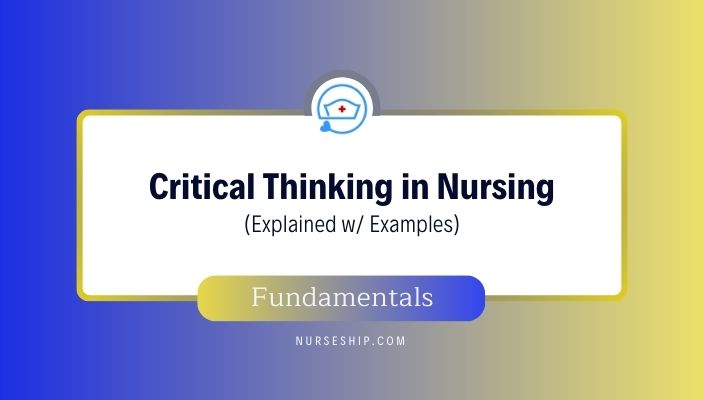
Last updated on August 23rd, 2023
Critical thinking is a foundational skill applicable across various domains, including education, problem-solving, decision-making, and professional fields such as science, business, healthcare, and more.
It plays a crucial role in promoting logical and rational thinking, fostering informed decision-making, and enabling individuals to navigate complex and rapidly changing environments.
In this article, we will look at what is critical thinking in nursing practice, its importance, and how it enables nurses to excel in their roles while also positively impacting patient outcomes.
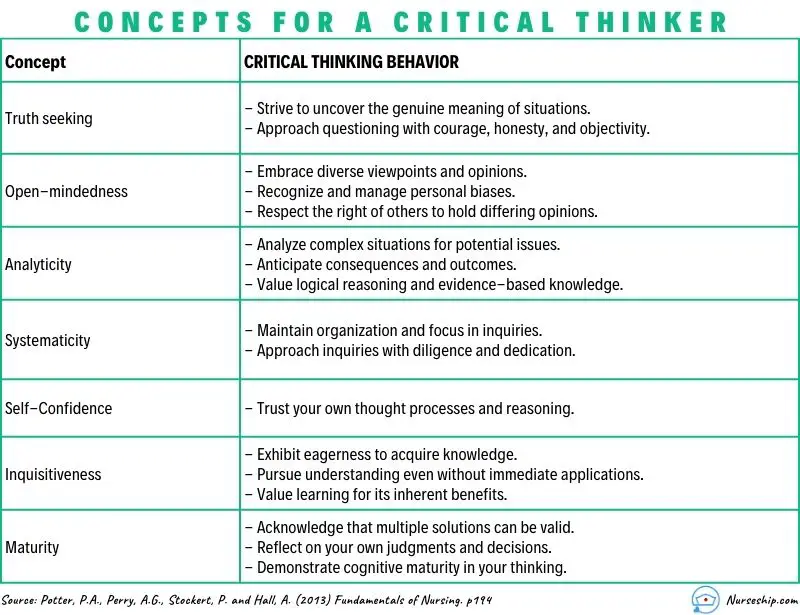
What is Critical Thinking?
Critical thinking is a cognitive process that involves analyzing, evaluating, and synthesizing information to make reasoned and informed decisions.
It’s a mental activity that goes beyond simple memorization or acceptance of information at face value.
Critical thinking involves careful, reflective, and logical thinking to understand complex problems, consider various perspectives, and arrive at well-reasoned conclusions or solutions.
Key aspects of critical thinking include:
- Analysis: Critical thinking begins with the thorough examination of information, ideas, or situations. It involves breaking down complex concepts into smaller parts to better understand their components and relationships.
- Evaluation: Critical thinkers assess the quality and reliability of information or arguments. They weigh evidence, identify strengths and weaknesses, and determine the credibility of sources.
- Synthesis: Critical thinking involves combining different pieces of information or ideas to create a new understanding or perspective. This involves connecting the dots between various sources and integrating them into a coherent whole.
- Inference: Critical thinkers draw logical and well-supported conclusions based on the information and evidence available. They use reasoning to make educated guesses about situations where complete information might be lacking.
- Problem-Solving: Critical thinking is essential in solving complex problems. It allows individuals to identify and define problems, generate potential solutions, evaluate the pros and cons of each solution, and choose the most appropriate course of action.
- Creativity: Critical thinking involves thinking outside the box and considering alternative viewpoints or approaches. It encourages the exploration of new ideas and solutions beyond conventional thinking.
- Reflection: Critical thinkers engage in self-assessment and reflection on their thought processes. They consider their own biases, assumptions, and potential errors in reasoning, aiming to improve their thinking skills over time.
- Open-Mindedness: Critical thinkers approach ideas and information with an open mind, willing to consider different viewpoints and perspectives even if they challenge their own beliefs.
- Effective Communication: Critical thinkers can articulate their thoughts and reasoning clearly and persuasively to others. They can express complex ideas in a coherent and understandable manner.
- Continuous Learning: Critical thinking encourages a commitment to ongoing learning and intellectual growth. It involves seeking out new knowledge, refining thinking skills, and staying receptive to new information.
Definition of Critical Thinking
Critical thinking is an intellectual process of analyzing, evaluating, and synthesizing information to make reasoned and informed decisions.
What is Critical Thinking in Nursing?
Critical thinking in nursing is a vital cognitive skill that involves analyzing, evaluating, and making reasoned decisions about patient care.
It’s an essential aspect of a nurse’s professional practice as it enables them to provide safe and effective care to patients.
Critical thinking involves a careful and deliberate thought process to gather and assess information, consider alternative solutions, and make informed decisions based on evidence and sound judgment.
This skill helps nurses to:
- Assess Information: Critical thinking allows nurses to thoroughly assess patient information, including medical history, symptoms, and test results. By analyzing this data, nurses can identify patterns, discrepancies, and potential issues that may require further investigation.
- Diagnose: Nurses use critical thinking to analyze patient data and collaboratively work with other healthcare professionals to formulate accurate nursing diagnoses. This is crucial for developing appropriate care plans that address the unique needs of each patient.
- Plan and Implement Care: Once a nursing diagnosis is established, critical thinking helps nurses develop effective care plans. They consider various interventions and treatment options, considering the patient’s preferences, medical history, and evidence-based practices.
- Evaluate Outcomes: After implementing interventions, critical thinking enables nurses to evaluate the outcomes of their actions. If the desired outcomes are not achieved, nurses can adapt their approach and make necessary changes to the care plan.
- Prioritize Care: In busy healthcare environments, nurses often face situations where they must prioritize patient care. Critical thinking helps them determine which patients require immediate attention and which interventions are most essential.
- Communicate Effectively: Critical thinking skills allow nurses to communicate clearly and confidently with patients, their families, and other members of the healthcare team. They can explain complex medical information and treatment plans in a way that is easily understood by all parties involved.
- Identify Problems: Nurses use critical thinking to identify potential complications or problems in a patient’s condition. This early recognition can lead to timely interventions and prevent further deterioration.
- Collaborate: Healthcare is a collaborative effort involving various professionals. Critical thinking enables nurses to actively participate in interdisciplinary discussions, share their insights, and contribute to holistic patient care.
- Ethical Decision-Making: Critical thinking helps nurses navigate ethical dilemmas that can arise in patient care. They can analyze different perspectives, consider ethical principles, and make morally sound decisions.
- Continual Learning: Critical thinking encourages nurses to seek out new knowledge, stay up-to-date with the latest research and medical advancements, and incorporate evidence-based practices into their care.
In summary, critical thinking is an integral skill for nurses, allowing them to provide high-quality, patient-centered care by analyzing information, making informed decisions, and adapting their approaches as needed.
It’s a dynamic process that enhances clinical reasoning , problem-solving, and overall patient outcomes.
What are the Levels of Critical Thinking in Nursing?
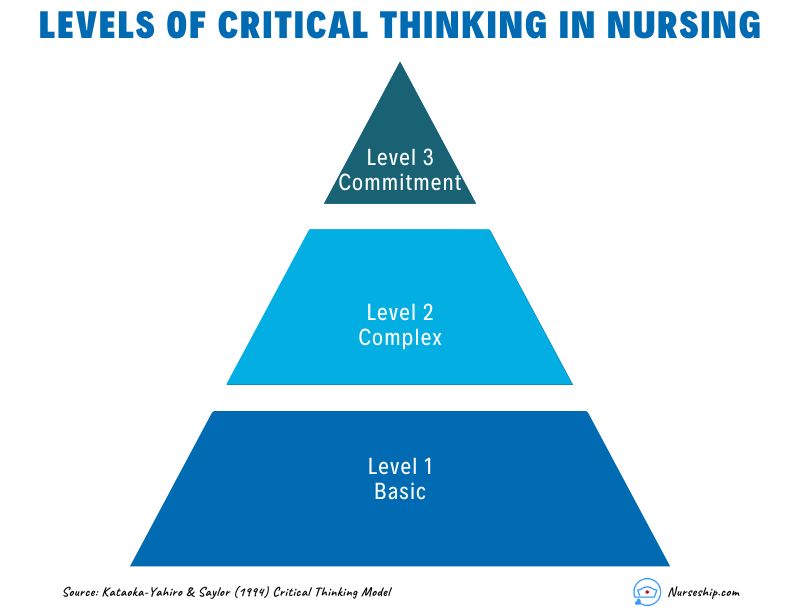
The development of critical thinking in nursing practice involves progressing through three levels: basic, complex, and commitment.
The Kataoka-Yahiro and Saylor model outlines this progression.
1. Basic Critical Thinking:
At this level, learners trust experts for solutions. Thinking is based on rules and principles. For instance, nursing students may strictly follow a procedure manual without personalization, as they lack experience. Answers are seen as right or wrong, and the opinions of experts are accepted.
2. Complex Critical Thinking:
Learners start to analyze choices independently and think creatively. They recognize conflicting solutions and weigh benefits and risks. Thinking becomes innovative, with a willingness to consider various approaches in complex situations.
3. Commitment:
At this level, individuals anticipate decision points without external help and take responsibility for their choices. They choose actions or beliefs based on available alternatives, considering consequences and accountability.
As nurses gain knowledge and experience, their critical thinking evolves from relying on experts to independent analysis and decision-making, ultimately leading to committed and accountable choices in patient care.
Why Critical Thinking is Important in Nursing?
Critical thinking is important in nursing for several crucial reasons:
Patient Safety:
Nursing decisions directly impact patient well-being. Critical thinking helps nurses identify potential risks, make informed choices, and prevent errors.
Clinical Judgment:
Nursing decisions often involve evaluating information from various sources, such as patient history, lab results, and medical literature.
Critical thinking assists nurses in critically appraising this information, distinguishing credible sources, and making rational judgments that align with evidence-based practices.
Enhances Decision-Making:
In nursing, critical thinking allows nurses to gather relevant patient information, assess it objectively, and weigh different options based on evidence and analysis.
This process empowers them to make informed decisions about patient care, treatment plans, and interventions, ultimately leading to better outcomes.
Promotes Problem-Solving:
Nurses encounter complex patient issues that require effective problem-solving.
Critical thinking equips them to break down problems into manageable parts, analyze root causes, and explore creative solutions that consider the unique needs of each patient.
Drives Creativity:
Nursing care is not always straightforward. Critical thinking encourages nurses to think creatively and explore innovative approaches to challenges, especially when standard protocols might not suffice for unique patient situations.
Fosters Effective Communication:
Communication is central to nursing. Critical thinking enables nurses to clearly express their thoughts, provide logical explanations for their decisions, and engage in meaningful dialogues with patients, families, and other healthcare professionals.
Aids Learning:
Nursing is a field of continuous learning. Critical thinking encourages nurses to engage in ongoing self-directed education, seeking out new knowledge, embracing new techniques, and staying current with the latest research and developments.
Improves Relationships:
Open-mindedness and empathy are essential in nursing relationships.
Critical thinking encourages nurses to consider diverse viewpoints, understand patients’ perspectives, and communicate compassionately, leading to stronger therapeutic relationships.
Empowers Independence:
Nursing often requires autonomous decision-making. Critical thinking empowers nurses to analyze situations independently, make judgments without undue influence, and take responsibility for their actions.
Facilitates Adaptability:
Healthcare environments are ever-changing. Critical thinking equips nurses with the ability to quickly assess new information, adjust care plans, and navigate unexpected situations while maintaining patient safety and well-being.
Strengthens Critical Analysis:
In the era of vast information, nurses must discern reliable data from misinformation.
Critical thinking helps them scrutinize sources, question assumptions, and make well-founded choices based on credible information.
How to Apply Critical Thinking in Nursing? (With Examples)
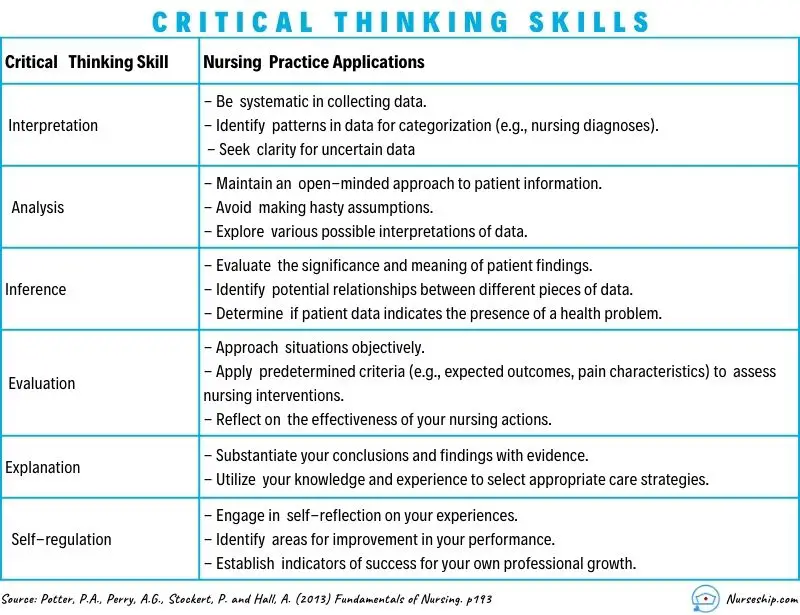
Here are some examples of how nurses can apply critical thinking.
Assess Patient Data:
Critical Thinking Action: Carefully review patient history, symptoms, and test results.
Example: A nurse notices a change in a diabetic patient’s blood sugar levels. Instead of just administering insulin, the nurse considers recent dietary changes, activity levels, and possible medication interactions before adjusting the treatment plan.
Diagnose Patient Needs:
Critical Thinking Action: Analyze patient data to identify potential nursing diagnoses.
Example: After reviewing a patient’s lab results, vital signs, and observations, a nurse identifies “ Risk for Impaired Skin Integrity ” due to the patient’s limited mobility.
Plan and Implement Care:
Critical Thinking Action: Develop a care plan based on patient needs and evidence-based practices.
Example: For a patient at risk of falls, the nurse plans interventions such as hourly rounding, non-slip footwear, and bed alarms to ensure patient safety.
Evaluate Interventions:
Critical Thinking Action: Assess the effectiveness of interventions and modify the care plan as needed.
Example: After administering pain medication, the nurse evaluates its impact on the patient’s comfort level and considers adjusting the dosage or trying an alternative pain management approach.
Prioritize Care:
Critical Thinking Action: Determine the order of interventions based on patient acuity and needs.
Example: In a busy emergency department, the nurse triages patients by considering the severity of their conditions, ensuring that critical cases receive immediate attention.
Collaborate with the Healthcare Team:
Critical Thinking Action: Participate in interdisciplinary discussions and share insights.
Example: During rounds, a nurse provides input on a patient’s response to treatment, which prompts the team to adjust the care plan for better outcomes.
Ethical Decision-Making:
Critical Thinking Action: Analyze ethical dilemmas and make morally sound choices.
Example: When a terminally ill patient expresses a desire to stop treatment, the nurse engages in ethical discussions, respecting the patient’s autonomy and ensuring proper end-of-life care.
Patient Education:
Critical Thinking Action: Tailor patient education to individual needs and comprehension levels.
Example: A nurse uses visual aids and simplified language to explain medication administration to a patient with limited literacy skills.
Adapt to Changes:
Critical Thinking Action: Quickly adjust care plans when patient conditions change.
Example: During post-operative recovery, a nurse notices signs of infection and promptly informs the healthcare team to initiate appropriate treatment adjustments.
Critical Analysis of Information:
Critical Thinking Action: Evaluate information sources for reliability and relevance.
Example: When presented with conflicting research studies, a nurse critically examines the methodologies and sample sizes to determine which study is more credible.
Making Sense of Critical Thinking Skills
What is the purpose of critical thinking in nursing.
The purpose of critical thinking in nursing is to enable nurses to effectively analyze, interpret, and evaluate patient information, make informed clinical judgments, develop appropriate care plans, prioritize interventions, and adapt their approaches as needed, thereby ensuring safe, evidence-based, and patient-centered care.
Why critical thinking is important in nursing?
Critical thinking is important in nursing because it promotes safe decision-making, accurate clinical judgment, problem-solving, evidence-based practice, holistic patient care, ethical reasoning, collaboration, and adapting to dynamic healthcare environments.
Critical thinking skill also enhances patient safety, improves outcomes, and supports nurses’ professional growth.
How is critical thinking used in the nursing process?
Critical thinking is integral to the nursing process as it guides nurses through the systematic approach of assessing, diagnosing, planning, implementing, and evaluating patient care. It involves:
- Assessment: Critical thinking enables nurses to gather and interpret patient data accurately, recognizing relevant patterns and cues.
- Diagnosis: Nurses use critical thinking to analyze patient data, identify nursing diagnoses, and differentiate actual issues from potential complications.
- Planning: Critical thinking helps nurses develop tailored care plans, selecting appropriate interventions based on patient needs and evidence.
- Implementation: Nurses make informed decisions during interventions, considering patient responses and adjusting plans as needed.
- Evaluation: Critical thinking supports the assessment of patient outcomes, determining the effectiveness of intervention, and adapting care accordingly.
Throughout the nursing process , critical thinking ensures comprehensive, patient-centered care and fosters continuous improvement in clinical judgment and decision-making.
What is an example of the critical thinking attitude of independent thinking in nursing practice?
An example of the critical thinking attitude of independent thinking in nursing practice could be:
A nurse is caring for a patient with a complex medical history who is experiencing a new set of symptoms. The nurse carefully reviews the patient’s history, recent test results, and medication list.
While discussing the case with the healthcare team, the nurse realizes that the current treatment plan might not be addressing all aspects of the patient’s condition.
Instead of simply following the established protocol, the nurse independently considers alternative approaches based on their assessment.
The nurse proposes a modification to the treatment plan, citing the rationale and evidence supporting the change.
This demonstrates independent thinking by critically evaluating the situation, challenging assumptions, and advocating for a more personalized and effective patient care approach.
How to use Costa’s level of questioning for critical thinking in nursing?
Costa’s levels of questioning can be applied in nursing to facilitate critical thinking and stimulate a deeper understanding of patient situations. The levels of questioning are as follows:
- 15 Attitudes of Critical Thinking in Nursing (Explained W/ Examples)
- Nursing Concept Map (FREE Template)
- Clinical Reasoning In Nursing (Explained W/ Example)
- 8 Stages Of The Clinical Reasoning Cycle
- How To Improve Critical Thinking Skills In Nursing? 24 Strategies With Examples
- What is the “5 Whys” Technique?
- What Are Socratic Questions?
Critical thinking in nursing is the foundation that underpins safe, effective, and patient-centered care.
Critical thinking skills empower nurses to navigate the complexities of their profession while consistently providing high-quality care to diverse patient populations.
Reading Recommendation
Potter, P.A., Perry, A.G., Stockert, P. and Hall, A. (2013) Fundamentals of Nursing
Comments are closed.
Medical & Legal Disclaimer
All the contents on this site are for entertainment, informational, educational, and example purposes ONLY. These contents are not intended to be used as a substitute for professional medical advice or practice guidelines. However, we aim to publish precise and current information. By using any content on this website, you agree never to hold us legally liable for damages, harm, loss, or misinformation. Read the privacy policy and terms and conditions.
Privacy Policy
Terms & Conditions
© 2024 nurseship.com. All rights reserved.
We use cookies on our website to support technical features that enhance your user experience, and to help us improve our website. By continuing to use this website, you accept our privacy policy .
- Student Login
- No-Cost Professional Certificates
- Call Us: 888-549-6755
- 888-559-6763
- Search site Search our site Search Now Close
- Request Info
Skip to Content (Press Enter)
Why Critical Thinking Skills in Nursing Matter (And What You Can Do to Develop Them)
By Hannah Meinke on 07/05/2021
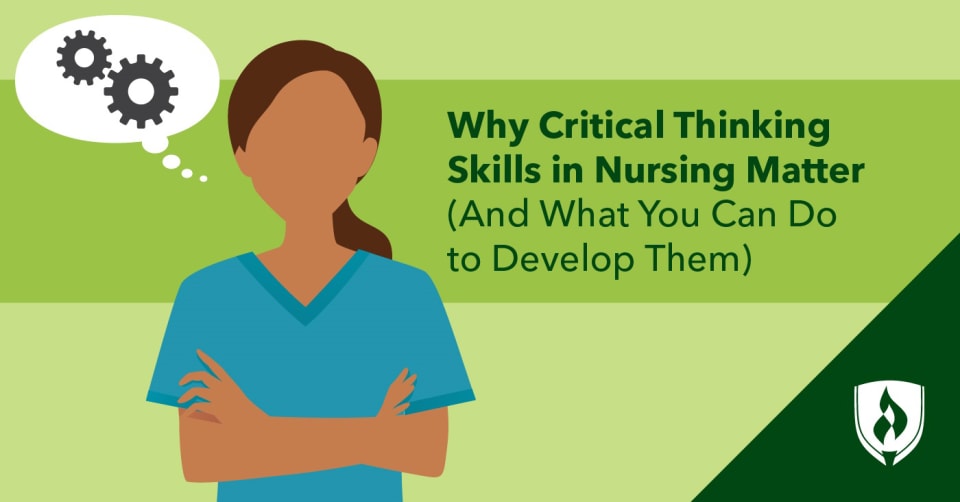
The nursing profession tends to attract those who have natural nurturing abilities, a desire to help others, and a knack for science or anatomy. But there is another important skill that successful nurses share, and it's often overlooked: the ability to think critically.
Identifying a problem, determining the best solution and choosing the most effective method to solve the program are all parts of the critical thinking process. After executing the plan, critical thinkers reflect on the situation to figure out if it was effective and if it could have been done better. As you can see, critical thinking is a transferable skill that can be leveraged in several facets of your life.
But why is it so important for nurses to use? We spoke with several experts to learn why critical thinking skills in nursing are so crucial to the field, the patients and the success of a nurse. Keep reading to learn why and to see how you can improve this skill.
Why are critical thinking skills in nursing important?
You learn all sorts of practical skills in nursing school, like flawlessly dressing a wound, taking vitals like a pro or starting an IV without flinching. But without the ability to think clearly and make rational decisions, those skills alone won’t get you very far—you need to think critically as well.
“Nurses are faced with decision-making situations in patient care, and each decision they make impacts patient outcomes. Nursing critical thinking skills drive the decision-making process and impact the quality of care provided,” says Georgia Vest, DNP, RN and senior dean of nursing at the Rasmussen University School of Nursing.
For example, nurses often have to make triage decisions in the emergency room. With an overflow of patients and limited staff, they must evaluate which patients should be treated first. While they rely on their training to measure vital signs and level of consciousness, they must use critical thinking to analyze the consequences of delaying treatment in each case.
No matter which department they work in, nurses use critical thinking in their everyday routines. When you’re faced with decisions that could ultimately mean life or death, the ability to analyze a situation and come to a solution separates the good nurses from the great ones.
How are critical thinking skills acquired in nursing school?
Nursing school offers a multitude of material to master and upholds high expectations for your performance. But in order to learn in a way that will actually equip you to become an excellent nurse, you have to go beyond just memorizing terms. You need to apply an analytical mindset to understanding course material.
One way for students to begin implementing critical thinking is by applying the nursing process to their line of thought, according to Vest. The process includes five steps: assessment, diagnosis, outcomes/planning, implementation and evaluation.
“One of the fundamental principles for developing critical thinking is the nursing process,” Vest says. “It needs to be a lived experience in the learning environment.”
Nursing students often find that there are multiple correct solutions to a problem. The key to nursing is to select the “the most correct” solution—one that will be the most efficient and best fit for that particular situation. Using the nursing process, students can narrow down their options to select the best one.
When answering questions in class or on exams, challenge yourself to go beyond simply selecting an answer. Start to think about why that answer is correct and what the possible consequences might be. Simply memorizing the material won’t translate well into a real-life nursing setting.
How can you develop your critical thinking skills as a nurse?
As you know, learning doesn’t stop with graduation from nursing school. Good nurses continue to soak up knowledge and continually improve throughout their careers. Likewise, they can continue to build their critical thinking skills in the workplace with each shift.
“To improve your critical thinking, pick the brains of the experienced nurses around you to help you get the mindset,” suggests Eileen Sollars, RN ADN, AAS. Understanding how a seasoned nurse came to a conclusion will provide you with insights you may not have considered and help you develop your own approach.
The chain of command can also help nurses develop critical thinking skills in the workplace.
“Another aid in the development of critical thinking I cannot stress enough is the utilization of the chain of command,” Vest says. “In the chain of command, the nurse always reports up to the nurse manager and down to the patient care aide. Peers and fellow healthcare professionals are not in the chain of command. Clear understanding and proper utilization of the chain of command is essential in the workplace.”
How are critical thinking skills applied in nursing?
“Nurses use critical thinking in every single shift,” Sollars says. “Critical thinking in nursing is a paramount skill necessary in the care of your patients. Nowadays there is more emphasis on machines and technical aspects of nursing, but critical thinking plays an important role. You need it to understand and anticipate changes in your patient's condition.”
As a nurse, you will inevitably encounter a situation in which there are multiple solutions or treatments, and you'll be tasked with determining the solution that will provide the best possible outcome for your patient. You must be able to quickly and confidently assess situations and make the best care decision in each unique scenario. It is in situations like these that your critical thinking skills will direct your decision-making.

Do critical thinking skills matter more for nursing leadership and management positions?
While critical thinking skills are essential at every level of nursing, leadership and management positions require a new level of this ability.
When it comes to managing other nurses, working with hospital administration, and dealing with budgets, schedules or policies, critical thinking can make the difference between a smooth-running or struggling department. At the leadership level, nurses need to see the big picture and understand how each part works together.
A nurse manager , for example, might have to deal with being short-staffed. This could require coaching nurses on how to prioritize their workload, organize their tasks and rely on strategies to keep from burning out. A lead nurse with strong critical thinking skills knows how to fully understand the problem and all its implications.
- How will patient care be affected by having fewer staff?
- What kind of strain will be on the nurses?
Their solutions will take into account all their resources and possible roadblocks.
- What work can be delegated to nursing aids?
- Are there any nurses willing to come in on their day off?
- Are nurses from other departments available to provide coverage?
They’ll weigh the pros and cons of each solution and choose those with the greatest potential.
- Will calling in an off-duty nurse contribute to burnout?
- Was this situation a one-off occurrence or something that could require an additional hire in the long term?
Finally, they will look back on the issue and evaluate what worked and what didn’t. With critical thinking skills like this, a lead nurse can affect their entire staff, patient population and department for the better.
Beyond thinking
You’re now well aware of the importance of critical thinking skills in nursing. Even if you already use critical thinking skills every day, you can still work toward strengthening that skill. The more you practice it, the better you will become and the more naturally it will come to you.
If you’re interested in critical thinking because you’d like to move up in your current nursing job, consider how a Bachelor of Science in Nursing (BSN) could help you develop the necessary leadership skills.
EDITOR’S NOTE: This article was originally published in July 2012. It has since been updated to include information relevant to 2021.
- Share on Facebook
- Share on Twitter
- Share on Pinterest
- Share on LinkedIn
Request More Information
Talk with an admissions advisor today. Fill out the form to receive information about:
- Program Details and Applying for Classes
- Financial Aid and FAFSA (for those who qualify)
- Customized Support Services
- Detailed Program Plan
There are some errors in the form. Please correct the errors and submit again.
Please enter your first name.
Please enter your last name.
There is an error in email. Make sure your answer has:
- An "@" symbol
- A suffix such as ".com", ".edu", etc.
There is an error in phone number. Make sure your answer has:
- 10 digits with no dashes or spaces
- No country code (e.g. "1" for USA)
There is an error in ZIP code. Make sure your answer has only 5 digits.
Please choose a School of study.
Please choose a program.
Please choose a degree.
The program you have selected is not available in your ZIP code. Please select another program or contact an Admissions Advisor (877.530.9600) for help.
The program you have selected requires a nursing license. Please select another program or contact an Admissions Advisor (877.530.9600) for help.
Rasmussen University is not enrolling students in your state at this time.
By selecting "Submit," I authorize Rasmussen University to contact me by email, phone or text message at the number provided. There is no obligation to enroll. This site is protected by reCAPTCHA and the Google Privacy Policy and Terms of Service apply.
About the author
Hannah Meinke

Posted in General Nursing
- nursing education
Related Content

Brianna Flavin | 03.19.2024

Robbie Gould | 11.14.2023

Noelle Hartt | 11.09.2023

Hope Rothenberg | 11.02.2023
This piece of ad content was created by Rasmussen University to support its educational programs. Rasmussen University may not prepare students for all positions featured within this content. Please visit www.rasmussen.edu/degrees for a list of programs offered. External links provided on rasmussen.edu are for reference only. Rasmussen University does not guarantee, approve, control, or specifically endorse the information or products available on websites linked to, and is not endorsed by website owners, authors and/or organizations referenced. Rasmussen University is accredited by the Higher Learning Commission, an institutional accreditation agency recognized by the U.S. Department of Education.
Critical Thinking in Nursing
- First Online: 02 January 2023
Cite this chapter

- Şefika Dilek Güven 3
Part of the book series: Integrated Science ((IS,volume 12))
1098 Accesses
Critical thinking is an integral part of nursing, especially in terms of professionalization and independent clinical decision-making. It is necessary to think critically to provide adequate, creative, and effective nursing care when making the right decisions for practices and care in the clinical setting and solving various ethical issues encountered. Nurses should develop their critical thinking skills so that they can analyze the problems of the current century, keep up with new developments and changes, cope with nursing problems they encounter, identify more complex patient care needs, provide more systematic care, give the most appropriate patient care in line with the education they have received, and make clinical decisions. The present chapter briefly examines critical thinking, how it relates to nursing, and which skills nurses need to develop as critical thinkers.
Graphical Abstract/Art Performance

Critical thinking in nursing.
This painting shows a nurse and how she is thinking critically. On the right side are the stages of critical thinking and on the left side, there are challenges that a nurse might face. The entire background is also painted in several colors to represent a kind of intellectual puzzle. It is made using colored pencils and markers.
(Adapted with permission from the Association of Science and Art (ASA), Universal Scientific Education and Research Network (USERN); Painting by Mahshad Naserpour).
Unless the individuals of a nation thinkers, the masses can be drawn in any direction. Mustafa Kemal Atatürk
This is a preview of subscription content, log in via an institution to check access.
Access this chapter
- Available as PDF
- Read on any device
- Instant download
- Own it forever
- Available as EPUB and PDF
- Compact, lightweight edition
- Dispatched in 3 to 5 business days
- Free shipping worldwide - see info
- Durable hardcover edition
Tax calculation will be finalised at checkout
Purchases are for personal use only
Institutional subscriptions
Bilgiç Ş, Kurtuluş Tosun Z (2016) Birinci ve son sınıf hemşirelik öğrencilerinde eleştirel düşünme ve etkileyen faktörler. Sağlık Bilimleri ve Meslekleri Dergisi 3(1):39–47
Article Google Scholar
Kantek F, Yıldırım N (2019) The effects of nursing education on critical thinking of students: a meta-analysis. Florence Nightingale Hemşirelik Dergisi 27(1):17–25
Ennis R (1996) Critical thinking dispositions: their nature and assessability. Informal Logic 18(2):165–182
Riddell T (2007) Critical assumptions: thinking critically about critical thinking. J Nurs Educ 46(3):121–126
Cüceloğlu D (2001) İyi düşün doğru karar ver. Remzi Kitabevi, pp 242–284
Google Scholar
Kurnaz A (2019) Eleştirel düşünme öğretimi etkinlikleri Planlama-Uygulama ve Değerlendirme. Eğitim yayın evi, p 27
Doğanay A, Ünal F (2006) Eleştirel düşünmenin öğretimi. In: İçerik Türlerine Dayalı Öğretim. Ankara Nobel Yayınevi, pp 209–261
Scheffer B-K, Rubenfeld M-G (2000) A consensus statement on critical thinking in nursing. J Nurs Educ 39(8):352–359
Article CAS Google Scholar
Rubenfeld M-G, Scheffer B (2014) Critical thinking tactics for nurses. Jones & Bartlett Publishers, pp 5–6, 7, 19–20
Gobet F (2005) Chunking models of expertise: implications for education. Appl Cogn Psychol 19:183–204
Ay F-A (2008) Mesleki temel kavramlar. In: Temel hemşirelik: Kavramlar, ilkeler, uygulamalar. İstanbul Medikal Yayıncılık, pp 205–220
Birol L (2010) Hemşirelik bakımında sistematik yaklaşım. In: Hemşirelik süreci. Berke Ofset Matbaacılık, pp 35–45
Twibell R, Ryan M, Hermiz M (2005) Faculty perceptions of critical thinking in student clinical experiences. J Nurs Educ 44(2):71–79
The Importance of Critical Thinking in Nursing. 19 November 2018 by Carson-Newman University Online. https://onlinenursing.cn.edu/news/value-critical-thinking-nursing
Suzanne C, Smeltzer Brenda G, Bare Janice L, Cheever HK (2010) Definition of critical thinking, critical thinking process. Medical surgical nursing. Lippincott, Williams & Wilkins, pp 27–28
Profetto-McGrath J (2003) The relationship of critical thinking skills and critical thinking dispositions of baccalaureate nursing students. J Adv Nurs 43(6):569–577
Elaine S, Mary C (2002) Critical thinking in nursing education: literature review. Int J Nurs Pract 8(2):89–98
Brunt B-A (2005) Critical thinking in nursing: an integrated review. J Continuing Educ Nurs 36(2):60–67
Carter L-M, Rukholm E (2008) A study of critical thinking, teacher–student interaction, and discipline-specific writing in an online educational setting for registered nurses. J Continuing Educ Nurs 39(3):133–138
Daly W-M (2001) The development of an alternative method in the assessment of critical thinking as an outcome of nursing education. J Adv Nurs 36(1):120–130
Edwards S-L (2007) Critical thinking: a two-phase framework. Nurse Educ Pract 7(5):303–314
Rogal S-M, Young J (2008) Exploring critical thinking in critical care nursing education: a pilot study. J Continuing Educ Nurs 39(1):28–33
Worrell J-A, Profetto-McGrath J (2007) Critical thinking as an outcome of context-based learning among post RN students: a literature review. Nurse Educ Today 27(5):420–426
Morrall P, Goodman B (2013) Critical thinking, nurse education and universities: some thoughts on current issues and implications for nursing practice. Nurse Educ Today 33(9):935–937
Raymond-Seniuk C, Profetto-McGrath J (2011) Can one learn to think critically?—a philosophical exploration. Open Nurs J 5:45–51
Download references
Author information
Authors and affiliations.
Nevşehir Hacı Bektaş Veli University, Semra ve Vefa Küçük, Faculty of Health Sciences, Nursing Department, 2000 Evler Mah. Damat İbrahim Paşa Yerleşkesi, Nevşehir, Turkey
Şefika Dilek Güven
You can also search for this author in PubMed Google Scholar
Corresponding author
Correspondence to Şefika Dilek Güven .
Editor information
Editors and affiliations.
Universal Scientific Education and Research Network (USERN), Stockholm, Sweden
Nima Rezaei
Rights and permissions
Reprints and permissions
Copyright information
© 2023 The Author(s), under exclusive license to Springer Nature Switzerland AG
About this chapter
Güven, Ş.D. (2023). Critical Thinking in Nursing. In: Rezaei, N. (eds) Brain, Decision Making and Mental Health. Integrated Science, vol 12. Springer, Cham. https://doi.org/10.1007/978-3-031-15959-6_10
Download citation
DOI : https://doi.org/10.1007/978-3-031-15959-6_10
Published : 02 January 2023
Publisher Name : Springer, Cham
Print ISBN : 978-3-031-15958-9
Online ISBN : 978-3-031-15959-6
eBook Packages : Behavioral Science and Psychology Behavioral Science and Psychology (R0)
Share this chapter
Anyone you share the following link with will be able to read this content:
Sorry, a shareable link is not currently available for this article.
Provided by the Springer Nature SharedIt content-sharing initiative
- Publish with us
Policies and ethics
- Find a journal
- Track your research

The Importance of Critical Thinking in Nursing

An American Association of Nurse Practitioners (AANP) survey found that a majority of nurse practitioners saw three or more patients per hour. Nurse practitioners see patients of all ages with a broad spectrum of potential ailments. Critical thinking skills in nursing improve patient outcomes by enabling evidence-based decision-making.
Nurse practitioners gather considerable amounts of patient data through evaluations, tests and conversations. Each patient's information can be interpreted and analyzed to determine the best courses of action for their health. A growing emphasis on critical thinking in nursing stems from the increasing importance of nurse practitioners in primary care.
Earn Your MSN-FNP Part-Time For Less than $30k
Growing need for critical thinking in nursing.
There is a significant shortage of primary care services throughout the United States. GoodRx identified 80% of counties as "health care deserts" or locations without easy access to necessary services. This data includes the following categories relevant to family nurse practitioners:
- 9% of counties lack enough primary care providers to serve the local population
- Residents in 20% of counties are at least 30 minutes away from hospitals
- Residents in 45% of counties are at least 20 minutes away from community health centers
"Health care deserts" are worsening because of a shortage of primary care physicians. The Association of American Medical Colleges ( AAMC ) estimates up to 48,000 more primary care providers are needed to meet patient care needs by 2034. This shortfall translates to a lack of preventive care and increased reliance on emergency care facilities.
The U.S. Bureau of Labor Statistics ( BLS ) projects a 52% growth in nurse practitioner roles by 2030. This growth is fueled not only by "health care deserts" but an aging population and public health threats like COVID-19. Critical thinking by nurse practitioners can overcome these challenges even with limited resources and stressful situations.
The Critical Thinking Process
The first step in incorporating critical thinking into patient care is understanding the critical thinking process. The National League for Nursing Accreditation Commission ( NLNAC ) defines critical thinking as:
"the deliberate nonlinear process of collecting, interpreting, analyzing, drawing conclusions about, presenting, and evaluating information that is both factually and belief based."
Critical thinking in nursing does not move in a straight line because each patient is unique. There isn't a one-size-fits-all diagnosis for patients because there isn't a single type of patient. Nurse practitioners can apply the following steps in the Clinical Reasoning Cycle as they evaluate patient care decisions.
Consider the Situation
First impressions of new patients can distract from effective evaluations. Personal experiences and assumptions may lead to hasty conclusions about patient needs. The first step to critical thinking in nursing involves a dispassionate consideration of the facts.
Nurse practitioners often have the basic facts about their patients' conditions before stepping into exam rooms. A simple repetition of the patient's age and reported illness counters assumptions that can negatively impact patient care.
Collect Information
Critical thinking requires the synthesis of existing and new information for effective analysis. Nurse practitioners can pull useful details from patient charts and histories when they are available. An evaluation of visual appearance, speech, blood pressure and other metrics builds on this previous work.
Skilled practitioners automatically apply their knowledge of physiology, pharmacology and other areas during the collection process. They also keep best practices, cultural competence and ethics in mind while working with patients. This recall makes it easier to process information during diagnosis.
Process Information
There is a multi-step process for turning raw information into useful insights for patient care. Nurse practitioners effectively process patient data by:
- Analyzing information within the context of normal and abnormal ranges
- Separating relevant and irrelevant data while finding information gaps
- Focus on relationships between symptoms and cues
- Deduce potential causes of health problems
- Compare similar situations between current and past patients
- Predict potential outcomes and complications from treatment
Nurse practitioners are ready to diagnose patient conditions following this process. Depending on symptoms, they'll have considered and eliminated multiple diagnoses based on careful consideration of the facts. This step also takes into consideration risks for other health issues without treatment.
Set Goals and Act
A patient's course of treatment should follow the SMART model for goal-setting. The best treatment plans are Specific, Measurable, Achievable, Realistic and Timely to support the measurement of their efficacy. This model creates a repeatable process that is effective across patient demographics and conditions.
Critical thinking in nursing produces clear goals that are essential to patient adherence to treatment. Treatment plans may include prescribed medications, therapies and visits with specialists. Nurse practitioners collaborate with their patients and colleagues on supportive frameworks for effective treatment.
Evaluate and Reflect
Follow-up appointments provide opportunities for evaluation of treatment plans. Nurse practitioners compare past and present metrics when determining improvements in patient conditions. A useful method for evaluating success is whether the following rights of clinical reasoning were applied:
- Right patient
- Right action
- Right reason
Frequent reflection on this process is essential for improvement as a nurse practitioner. Self-directed explorations of what should have been done and what could have happened in each case sharpen critical thinking skills. An understanding of what was learned in each case creates points of comparison for future patients.
Improving Your Critical Thinking
Critical thinking in nursing improves through thoughtful deliberation and frequent use. Nurse practitioners should speak with their colleagues and mentors about their applications of critical thinking. Frequent collaboration on patient care also places the focus on evidence-based care rather than personal assumptions.
Updated knowledge of nursing resources and tools makes it easier to implement critical thinking in nursing. Medical journals and continuing education courses reinforce what nurse practitioners have learned throughout their careers. Carson-Newman University provides a strong foundation for improved critical thinking through its Online MSN-FNP.
Preparing for Clinical Decisions at Carson-Newman
Carson-Newman's innovative program prepares BSN & MSN-educated nurses for future roles as family nurse practitioners (FNPs). The in-person requirements for this 100% online degree are clinical placements and a three-day campus residency. Students can complete the Online MSN-FNP in as little as 32 months.
Every course in the program is taught by an experienced nurse educator who also practices in their community. Carson-Newman reinforces the importance of critical thinking in nursing with courses on topics including:
- Advanced Health Assessment
- Advanced Pathophysiology
- Advanced Primary Care Nursing for Adults
FNP students receive full support from Carson-Newman to identify clinical placements in their communities. They also receive one-on-one guidance from Student Success Advisors throughout their time at the University. This commitment to nursing education helped Carson-Newman reach the top third of graduate nursing programs in U.S. News & World Report's rankings.
Contact an enrollment advisor today to learn how Carson-Newman can prepare you for a role as an FNP.
Request Your Free Program Brochure
- NCSBN Member Login Submit
Access provided by
Login to your account
If you don't remember your password, you can reset it by entering your email address and clicking the Reset Password button. You will then receive an email that contains a secure link for resetting your password
If the address matches a valid account an email will be sent to __email__ with instructions for resetting your password
Download started.
- Academic & Personal: 24 hour online access
- Corporate R&D Professionals: 24 hour online access
- Add To Online Library Powered By Mendeley
- Add To My Reading List
- Export Citation
- Create Citation Alert
Critical Thinking TACTICS for Nurses: Achieving the IOM Competencies
- M. Gaie Rubenfeld M. Gaie Rubenfeld Search for articles by this author
- Barbara K. Scheffer Barbara K. Scheffer Search for articles by this author
Purchase one-time access:
- For academic or personal research use, select 'Academic and Personal'
- For corporate R&D use, select 'Corporate R&D Professionals'
Article info
© 2010 Jones and Bartlett, Sudbury, MA. ISBN-13: 9780763765842 (second edition)
Identification
DOI: https://doi.org/10.1016/S2155-8256(15)30371-9
ScienceDirect
Related articles.
- Download Hi-res image
- Download .PPT
- Access for Developing Countries
- Articles & Issues
- Current Issue
- List of Issues
- Supplements
- For Authors
- Guide for Authors
- Author Services
- Permissions
- Researcher Academy
- Submit a Manuscript
- Journal Info
- About the Journal
- Contact Information
- Editorial Board
- New Content Alerts
- Call for Papers
- January & April 2022 Issues
The content on this site is intended for healthcare professionals.
- Privacy Policy
- Terms and Conditions
- Accessibility
- Help & Contact

How do nurses promote critical thinking in acute care? A scoping literature review
Affiliations.
- 1 Southern District Health Board, Dunedin, New Zealand.
- 2 Centre for Medical and Health Sciences Education, The University of Auckland, New Zealand.
- 3 Centre for Medical and Health Sciences Education, The University of Auckland, New Zealand. Electronic address: [email protected].
- PMID: 33992878
- DOI: 10.1016/j.nepr.2021.103074
Aim: Critical thinking is essential to quality health care and patient outcomes in the acute care setting. It is important for educators to understand and apply teaching and learning strategies to promote critical thinking of nursing students and junior nurses in acute care.
Design: We followed Arksey and O'Malley's 2005 framework to undertake a scoping literature review to find out how critical thinking is promoted among nursing learners (i.e., nursing students and junior nurses) in acute care.
Methods: Between September and October 2018, four databases were searched: MEDLINE, CINAHL, ERIC, and Google Scholar. Search terms included: rapid, teaching, methods, nursing, promote, critical thinking and acute setting. A descriptive thematic analysis was undertaken.
Results: Twenty-three articles were included for review. Three main themes were identified from the analysis: learner-teacher relationship, reflection, and inquiry. Strong relationships promoted positive role modelling and effective feedback - both contributing to the teaching of critical thinking. Reflection strategies such as concept mapping and journaling were frequently used, while active student inquiry further promoted critical thinking in the acute setting.
Conclusions: The acute setting affords opportunities and challenges to promote critical thinking. Teachers/clinicians should incorporate learner-centred pedagogy and encourage reflective practice to embed critical thinking in teaching and clinical practice.
Keywords: Acute care; Critical thinking; Learning; Nurse education; Scoping review.
Copyright © 2021 Elsevier Ltd. All rights reserved.
Publication types
- Students, Nursing*
- - Google Chrome
Intended for healthcare professionals
- Access provided by Google Indexer
- My email alerts
- BMA member login
- Username * Password * Forgot your log in details? Need to activate BMA Member Log In Log in via OpenAthens Log in via your institution

Search form
- Advanced search
- Search responses
- Search blogs
- News & Views
- Critical thinking in...
Critical thinking in healthcare and education
- Related content
- Peer review
- Jonathan M Sharples , professor 1 ,
- Andrew D Oxman , research director 2 ,
- Kamal R Mahtani , clinical lecturer 3 ,
- Iain Chalmers , coordinator 4 ,
- Sandy Oliver , professor 1 ,
- Kevan Collins , chief executive 5 ,
- Astrid Austvoll-Dahlgren , senior researcher 2 ,
- Tammy Hoffmann , professor 6
- 1 EPPI-Centre, UCL Department of Social Science, London, UK
- 2 Global Health Unit, Norwegian Institute of Public Health, Oslo, Norway
- 3 Centre for Evidence-Based Medicine, Oxford University, Oxford, UK
- 4 James Lind Initiative, Oxford, UK
- 5 Education Endowment Foundation, London, UK
- 6 Centre for Research in Evidence-Based Practice, Bond University, Gold Coast, Australia
- Correspondence to: J M Sharples Jonathan.Sharples{at}eefoundation.org.uk
Critical thinking is just one skill crucial to evidence based practice in healthcare and education, write Jonathan Sharples and colleagues , who see exciting opportunities for cross sector collaboration
Imagine you are a primary care doctor. A patient comes into your office with acute, atypical chest pain. Immediately you consider the patient’s sex and age, and you begin to think about what questions to ask and what diagnoses and diagnostic tests to consider. You will also need to think about what treatments to consider and how to communicate with the patient and potentially with the patient’s family and other healthcare providers. Some of what you do will be done reflexively, with little explicit thought, but caring for most patients also requires you to think critically about what you are going to do.
Critical thinking, the ability to think clearly and rationally about what to do or what to believe, is essential for the practice of medicine. Few doctors are likely to argue with this. Yet, until recently, the UK regulator the General Medical Council and similar bodies in North America did not mention “critical thinking” anywhere in their standards for licensing and accreditation, 1 and critical thinking is not explicitly taught or assessed in most education programmes for health professionals. 2
Moreover, although more than 2800 articles indexed by PubMed have “critical thinking” in the title or abstract, most are about nursing. We argue that it is important for clinicians and patients to learn to think critically and that the teaching and learning of these skills should be considered explicitly. Given the shared interest in critical thinking with broader education, we also highlight why healthcare and education professionals and researchers need to work together to enable people to think critically about the health choices they make throughout life.
Essential skills for doctors and patients
Critical thinking is not a new concept in education: at the beginning of the last century the US educational reformer John Dewey identified the need to help students “to think well.” 3 Critical thinking encompasses a broad set of skills and dispositions, including cognitive skills (such as analysis, inference, and self regulation); approaches to specific questions or problems (orderliness, diligence, and reasonableness); and approaches to life in general (inquisitiveness, concern with being well informed, and open mindedness). 4
An increasing body of evidence highlights that developing critical thinking skills can benefit academic outcomes as well as wider reasoning and problem solving capabilities. 5 For example, the Thinking, Doing, Talking Science programme trains teachers in a repertoire of strategies that encourage pupils to use critical thinking skills in primary school science lessons. An independently conducted randomised trial of this approach found that it had a positive impact on pupils’ science attainment, with signs that it was particularly beneficial for pupils from poorer families. 6
In medicine, increasing attention has been paid to “critical appraisal” in the past 40 years. Critical appraisal is a subset of critical thinking that focuses on how to use research evidence to inform health decisions. 7 8 9 The need for critical appraisal in medicine was recognised at least 75 years ago, 10 and critical appraisal has been recognised for some decades as an essential competency for healthcare professionals. 11 The General Medical Council’s Good Medical Practice guidance includes the need for doctors to be able to “provide effective treatments based on the best available evidence.” 12
If patients and the public are to make well informed health choices, they must also be able to assess the reliability of health claims and information. This is something that most people struggle to do, and it is becoming increasingly important because patients are taking on a bigger role in managing their health and making healthcare decisions, 13 while needing to cope with more and more health information, much of which is not reliable. 14 15 16 17
Teaching critical thinking
Although critical thinking skills are given limited explicit attention in standards for medical education, they are included as a key competency in most frameworks for national curriculums for primary and secondary schools in many countries. 18 Nonetheless, much health and science education, and education generally, still tends towards rote learning rather than the promotion of critical thinking. 19 20 This matters because the ability to think critically is an essential life skill relevant to decision making in many circumstances. The capacity to think critically is, like a lot of learning, developed in school and the home: parental influence creates advantage for pupils who live in homes where they are encouraged to think and talk about what they are doing. This, importantly, goes beyond simply completing tasks to creating deeper understanding of learning processes. As such, the “critical thinking gap” between children from disadvantaged communities and their more advantaged peers requires attention as early as possible.
Although it is possible to teach critical thinking to adults, it is likely to be more productive if the grounds for this have been laid down in an educational environment early in life, starting in primary school. Erroneous beliefs, attitudes, and behaviours developed during childhood may be difficult to change later. 21 22 This also applies to medical education and to health professionals. It becomes increasingly difficult to teach these skills without a foundation to build on and adequate time to learn them.
Strategies for teaching students to think critically have been evaluated in health and medical education; in science, technology, engineering, and maths; and in other subjects. 23 These studies suggest that critical thinking skills can be taught and that in the absence of explicit teaching of critical thinking, important deficiencies emerge in the abilities of students to make sound judgments. In healthcare studies, many medical students score poorly on tests that measure the ability to think critically , and the ability to think critically is correlated with academic success. 24 25
Evaluations of strategies for teaching critical thinking in medicine have focused primarily on critical appraisal skills as part of evidence based healthcare. An overview of systematic reviews of these studies suggests that improving evidence based healthcare competencies is likely to require multifaceted, clinically integrated approaches that include assessment. 26
Cross sector collaboration
Informed Health Choices, an international project aiming to improve decision making, shows the opportunities and benefits of cross sector collaboration between education and health. 27 This project has brought together people working in education and healthcare to develop a curriculum and learning resources for critical thinking about any action that is claimed to improve health. It aims to develop, identify, and promote the use of effective learning resources, beginning at primary school, to help people to make well informed choices as patients and health professionals, and well informed decisions as citizens and policy makers.
The project has drawn on several approaches used in education, including the development of a “spiral curriculum,” measurement tools, and the design of learning resources. A spiral curriculum begins with determining what people should know and be able to do, and outlines where they should begin and how they should progress to reach these goals. The basic ideas are revisited repeatedly, building on them until the student has grasped a deep understanding of the concepts. 28 29 The project has also drawn on educational research and methods to develop reliable and valid tools for measuring the extent to which those goals have been achieved. 30 31 32 The development of learning resources to teach these skills has been informed by educational research, including educational psychology, motivational psychology, and research and methods for developing learning games. 33 34 35 It has also built on the traditions of clinical epidemiology and evidence based medicine to identify the key concepts required to assess health claims. 29
It is difficult to teach critical thinking abstractly, so focusing on health may have advantages beyond the public health benefits of increasing health literacy. 36 Nearly everyone is interested in health, including children, making it easy to engage learners. It is also immediately relevant to students. As reported by one 10 year old in a school that piloted primary school resources, this is about “things we might actually use instead of things we might use when we are all grown up and by then we’ll forget.” Although the current evaluation of the project is focusing on outcomes relating to appraisal of treatment claims, if the intervention shows promise the next step could be to explore how these skills translate to wider educational contexts and outcomes.
Beyond critical thinking
Exciting opportunities for cross sector collaboration are emerging between healthcare and education. Although critical thinking is a useful example of this, other themes cross the education and healthcare domains, including nutrition, exercise, educational neuroscience, learning disabilities and special education needs, and mental health.
In addition to shared topics, several common methodological and conceptual issues also provide opportunities for sharing ideas and innovations and learning from mistakes and successes. For example, the Education Endowment Foundation is the UK government’s What Works Centre for education, aiming to improve evidence based decision making. Discussions hosted by the foundation are exploring how methods to develop guidelines in healthcare can be adapted and applied in education and other sectors.
Similarly, the foundation’s universal use of independent evaluation for teaching and learning interventions is an approach that should be explored, adapted, and applied in healthcare. Since the development and evaluation of educational interventions are separated, evaluators have no vested interested in the results of the assessment, all results are published, and bias and spin in how results are analysed and presented are reduced. By contrast, industry sponsorship of drug and device studies consistently produces results that favour the manufacturer. 37
Another example of joint working between educators and health is the Best Evidence Medical Education Collaboration, an international collaboration focused on improving education of health professionals. 38 And in the UK, the Centre for Evidence Based Medicine coordinates Evidence in School Teaching (Einstein), a project that supports introducing evidence based medicine as part of wider science activities in schools. 39 It aims to engage students, teachers, and the public in evidence based medicine and develop critical thinking to assess health claims and make better choices.
Collaboration has also been important in the development of the Critical Thinking and Appraisal Resource Library (CARL), 40 a set of resources designed to help people understand fair comparisons of treatments. An important aim of CARL is to promote evaluation of these critical thinking resources and interventions, some of which are currently under way at the Education Endowment Foundation. On 22 May 2017, the foundation is also cohosting an event with the Royal College of Paediatrics and Child Health that will focus on their shared interest in critical thinking and appraisal skills.
Education and healthcare have overlapping interests. Doctors, teachers, researchers, patients, learners, and the public can all benefit from working together to help people to think critically about the choices they make. Events such as the global evidence summit in September 2017 ( https://globalevidencesummit.org ) can help bring people together and build on current international experience.
Contributors and sources: This article reflects conclusions from discussions during 2016 among education and health service researchers exploring opportunities for cross sector collaboration and learning. This group includes people with a longstanding interest in evidence informed policy and practice, with expertise in evaluation design, reviewing methodology, knowledge mobilisation, and critical thinking and appraisal.
Competing interests: We have read and understood BMJ policy on declaration of interests and declare that we have no competing interests.
Provenance and peer review: Not commissioned; externally peer reviewed.
- ↵ Krupat E, Sprague JM, Wolpaw D, Haidet P, Hatem D, O’Brien B. Thinking critically about critical thinking: ability, disposition or both? Med Educ 2011 ; 357 : 625 - 35 . doi:10.1111/j.1365-2923.2010.03910.x pmid:21564200 . OpenUrl
- ↵ Huang GC, Newman LR, Schwartzstein RM. Critical thinking in health professions education: summary and consensus statements of the millennium conference 2011. Teach Learn Med 2014 ; 357 : 95 - 102 . doi:10.1080/10401334.2013.857335 pmid:24405353 . OpenUrl
- ↵ Dewey J. How we think. D C Heath, 1910 . https://archive.org/details/howwethink000838mbp doi:10.1037/10903-000 .
- ↵ Facione PA. Critical thinking: a statement of expert consensus for purposes of educational assessment and instruction. Research findings and recommendations. American Philosophical Association, 1990 , http://files.eric.ed.gov/fulltext/ED315423.pdf .
- ↵ Higgins S, Katsipataki M, Coleman R, et al. The Sutton Trust-Education Endowment Foundation Teaching and Learning Toolkit. Education Endowment Foundation, 2015 .
- ↵ Hanley P, Slavin RE, Elliot L. Thinking, doing, talking science. Evaluation report and executive summary. Education Endowment Foundation, 2015 , https://v1.educationendowmentfoundation.org.uk/uploads/pdf/Oxford_Science.pdf .
- ↵ Sackett DL. How to read clinical journals: I. why to read them and how to start reading them critically . Can Med Assoc J 1981 ; 357 : 555 - 8 . pmid:7471000 . OpenUrl
- ↵ Guyatt G, Cairns J, Churchill D, et al. Evidence-Based Medicine Working Group. Evidence-based medicine. A new approach to teaching the practice of medicine . JAMA 1992 ; 357 : 2420 - 5 . doi:10.1001/jama.1992.03490170092032 pmid:1404801 . OpenUrl
- ↵ Oxman AD, Sackett DL, Guyatt GH. The Evidence-Based Medicine Working Group. Users’ guides to the medical literature. I. How to get started . JAMA 1993 ; 357 : 2093 - 5 . doi:10.1001/jama.1993.03510170083036 pmid:8411577 . OpenUrl
- ↵ Rynearson EH. Endocrinology: a critical appraisal . Cal West Med 1940 ; 357 : 257 - 9 . pmid:18745588 . OpenUrl
- ↵ General Medical Council. Tomorrow's doctors. General Medical Council, 1993. http://www.gmc-uk.org/10a_annex_a.pdf_25398162.pdf
- ↵ General Medical Council. Good medical practice. General Medical Council, 2013. http://www.gmc-uk.org/static/documents/content/GMP_.pdf
- ↵ Edwards A, Elwyn G. Shared decision-making in health care: achieving evidence-based patient choice. 2nd ed . Oxford University Press, 2009 .
- ↵ Sumner P, Vivian-Griffiths S, Boivin J, et al. Exaggerations and caveats in press releases and health-related science news. PLoS One 2016 ; 357 : e0168217 . doi:10.1371/journal.pone.0168217 pmid:27978540 . OpenUrl
- ↵ Schwartz LM, Woloshin S, Andrews A, Stukel TA. Influence of medical journal press releases on the quality of associated newspaper coverage: retrospective cohort study. BMJ 2012 ; 357 : d8164 . doi:10.1136/bmj.d8164 . pmid:22286507 . OpenUrl
- ↵ Glenton C, Paulsen EJ, Oxman AD. Portals to Wonderland: health portals lead to confusing information about the effects of health care. BMC Med Inform Decis Mak 2005 ; 357 : 7 . doi:10.1186/1472-6947-5-7 pmid:15769291 . OpenUrl
- ↵ Moynihan R, Bero L, Ross-Degnan D, et al. Coverage by the news media of the benefits and risks of medications . N Engl J Med 2000 ; 357 : 1645 - 50 . doi:10.1056/NEJM200006013422206 pmid:10833211 . OpenUrl
- ↵ Voogt J, Roblin NP. A comparative analysis of international frameworks for 21st century competences: implications for national curriculum policies. J Curric Stud 2012 ; 357 : 299 - 321 doi:10.1080/00220272.2012.668938 . OpenUrl
- ↵ National Research Council. Taking science to school: learning and teaching science in grades K-8. National Academies Press, 2007 .
- ↵ Nordheim L, Pettersen KS, Flottorp S, Hjälmhult E. Critical appraisal of health claims: science teachers’ perceptions and practices . Health Educ J 2016 ; 357 : 449 - 66 doi:10.1108/HE-04-2015-0016 . OpenUrl
- ↵ Committee on Science Learning. Kindergarten through eighth grade. How children learn science. In: Duschl RA, Schweingruber A, Shouse AW, eds. Taking science to school: learning and teaching science in grades K-8. National Academies Press, 2007 .
- ↵ Vosniadou S. International handbook of research on conceptual change. 2nd ed . Routledge, 2013 .
- ↵ Abrami PC, Bernard RM, Borokhovski E, Waddington DI, Wade CA, Persson T. Strategies for teaching students to think critically a meta-analysis. Rev Educ Res 2015 ; 357 : 275 - 314 . OpenUrl
- ↵ Ross D, Schipper S, Westbury C, et al. Examining critical thinking skills in family medicine residents . Fam Med 2016 ; 357 : 121 - 6 . pmid:26950783 . OpenUrl
- ↵ Ross D, Loeffler K, Schipper S, Vandermeer B, Allan GM. Do scores on three commonly used measures of critical thinking correlate with academic success of health professions trainees? A systematic review and meta-analysis. Acad Med 2013 ; 357 : 724 - 34 . doi:10.1097/ACM.0b013e31828b0823 pmid:23524925 . OpenUrl
- ↵ Young T, Rohwer A, Volmink J, Clarke M. What are the effects of teaching evidence-based health care (EBHC)? Overview of systematic reviews. PLoS One 2014 ; 357 : e86706 . doi:10.1371/journal.pone.0086706 pmid:24489771 . OpenUrl
- ↵ Informed Health Choices Group. Informed health choices. www.informedhealthchoices.org
- ↵ Harden RM, Stamper N. What is a spiral curriculum? Med Teach 1999 ; 357 : 141 - 3 . doi:10.1080/01421599979752 pmid:21275727 . OpenUrl
- ↵ Austvoll-Dahlgren A, Oxman AD, Chalmers I, et al. Key concepts that people need to understand to assess claims about treatment effects. J Evid Based Med 2015 ; 357 : 112 - 25 . doi:10.1111/jebm.12160 pmid:26107552 . OpenUrl
- ↵ Austvoll-Dahlgren A, Nsangi A, Semakula D. Interventions and assessment tools addressing key concepts people need to know to appraise claims about treatment effects: a systematic mapping review. Syst Rev 2016 ; 357 : 215 . doi:10.1186/s13643-016-0389-z pmid:28034307 . OpenUrl
- ↵ Austvoll-Dahlgren A, Semakula D, Nsangi A, et al. The development of the “claim evaluation tools”: assessing critical thinking about effects. BMJ Open forthcoming .
- ↵ Austvoll-Dahlgren A, Guttersrud Ø, Semakula D, Nsangi A, Oxman AD. Measuring ability to assess claims about treatment effects: a latent trait analysis of the claim evaluation tools using Rasch modelling. BMJ Open [ forthcoming ].
- ↵ Sandoval WA, Sodian B, Koerber S, Wong J. Developing children’s early competencies to engage with science . Educ Psychol 2014 ; 357 : 139 - 52 doi:10.1080/00461520.2014.917589 . OpenUrl
- ↵ Pintrich PR. A motivational science perspective on the role of student motivation in learning and teaching contexts . J Educ Psychol 2003 ; 357 : 667 - 86 doi:10.1037/0022-0663.95.4.667 . OpenUrl
- ↵ Clark DB, Tanner-Smith EE, Killingsworth SS. Digital games, design, and learning: a systematic review and meta-analysis . Rev Educ Res 2016 ; 357 : 79 - 122 . doi:10.3102/0034654315582065 pmid:26937054 . OpenUrl
- ↵ Berkman ND, Sheridan SL, Donahue KE, Halpern DJ, Crotty K. Low health literacy and health outcomes: an updated systematic review . Ann Intern Med 2011 ; 357 : 97 - 107 . doi:10.7326/0003-4819-155-2-201107190-00005 pmid:21768583 . OpenUrl
- ↵ Lundh A, Sismondo S, Lexchin J, Busuioc OA, Bero L. Industry sponsorship and research outcome. Cochrane Database Syst Rev 2012 ; 357 : MR000033 . pmid:23235689 . OpenUrl
- ↵ Thistlethwaite J, Hammick M, The Best Evidence Medical Education (BEME) Collaboration: into the next decade. Med Teach 2010 ; 357 : 880 - 2 . doi:10.3109/0142159X.2010.519068 pmid:21039096 . OpenUrl
- ↵ Centre for Evidence Based Medicine. Einstein—taking EBM to schools. http://www.cebm.net/taking-ebm-schools
- ↵ Castle JC, Chalmers I, Atkinson P, et al. Establishing a library of resources to help people understand key concepts in assessing treatment claims—the Critical Thinking and Appraisal Resource Library (CARL). PLoS One forthcoming .
Suggestions or feedback?
MIT News | Massachusetts Institute of Technology
- Machine learning
- Social justice
- Black holes
- Classes and programs
Departments
- Aeronautics and Astronautics
- Brain and Cognitive Sciences
- Architecture
- Political Science
- Mechanical Engineering
Centers, Labs, & Programs
- Abdul Latif Jameel Poverty Action Lab (J-PAL)
- Picower Institute for Learning and Memory
- Lincoln Laboratory
- School of Architecture + Planning
- School of Engineering
- School of Humanities, Arts, and Social Sciences
- Sloan School of Management
- School of Science
- MIT Schwarzman College of Computing
MIT faculty, instructors, students experiment with generative AI in teaching and learning
Press contact :.

Previous image Next image
How can MIT’s community leverage generative AI to support learning and work on campus and beyond?
At MIT’s Festival of Learning 2024, faculty and instructors, students, staff, and alumni exchanged perspectives about the digital tools and innovations they’re experimenting with in the classroom. Panelists agreed that generative AI should be used to scaffold — not replace — learning experiences.
This annual event, co-sponsored by MIT Open Learning and the Office of the Vice Chancellor, celebrates teaching and learning innovations. When introducing new teaching and learning technologies, panelists stressed the importance of iteration and teaching students how to develop critical thinking skills while leveraging technologies like generative AI.
“The Festival of Learning brings the MIT community together to explore and celebrate what we do every day in the classroom,” said Christopher Capozzola, senior associate dean for open learning. “This year's deep dive into generative AI was reflective and practical — yet another remarkable instance of ‘mind and hand’ here at the Institute.”

Incorporating generative AI into learning experiences
MIT faculty and instructors aren’t just willing to experiment with generative AI — some believe it’s a necessary tool to prepare students to be competitive in the workforce. “In a future state, we will know how to teach skills with generative AI, but we need to be making iterative steps to get there instead of waiting around,” said Melissa Webster, lecturer in managerial communication at MIT Sloan School of Management.
Some educators are revisiting their courses’ learning goals and redesigning assignments so students can achieve the desired outcomes in a world with AI. Webster, for example, previously paired written and oral assignments so students would develop ways of thinking. But, she saw an opportunity for teaching experimentation with generative AI. If students are using tools such as ChatGPT to help produce writing, Webster asked, “how do we still get the thinking part in there?”
One of the new assignments Webster developed asked students to generate cover letters through ChatGPT and critique the results from the perspective of future hiring managers. Beyond learning how to refine generative AI prompts to produce better outputs, Webster shared that “students are thinking more about their thinking.” Reviewing their ChatGPT-generated cover letter helped students determine what to say and how to say it, supporting their development of higher-level strategic skills like persuasion and understanding audiences.
Takako Aikawa, senior lecturer at the MIT Global Studies and Languages Section, redesigned a vocabulary exercise to ensure students developed a deeper understanding of the Japanese language, rather than just right or wrong answers. Students compared short sentences written by themselves and by ChatGPT and developed broader vocabulary and grammar patterns beyond the textbook. “This type of activity enhances not only their linguistic skills but stimulates their metacognitive or analytical thinking,” said Aikawa. “They have to think in Japanese for these exercises.”
While these panelists and other Institute faculty and instructors are redesigning their assignments, many MIT undergraduate and graduate students across different academic departments are leveraging generative AI for efficiency: creating presentations, summarizing notes, and quickly retrieving specific ideas from long documents. But this technology can also creatively personalize learning experiences. Its ability to communicate information in different ways allows students with different backgrounds and abilities to adapt course material in a way that’s specific to their particular context.
Generative AI, for example, can help with student-centered learning at the K-12 level. Joe Diaz, program manager and STEAM educator for MIT pK-12 at Open Learning, encouraged educators to foster learning experiences where the student can take ownership. “Take something that kids care about and they’re passionate about, and they can discern where [generative AI] might not be correct or trustworthy,” said Diaz.
Panelists encouraged educators to think about generative AI in ways that move beyond a course policy statement. When incorporating generative AI into assignments, the key is to be clear about learning goals and open to sharing examples of how generative AI could be used in ways that align with those goals.
The importance of critical thinking
Although generative AI can have positive impacts on educational experiences, users need to understand why large language models might produce incorrect or biased results. Faculty, instructors, and student panelists emphasized that it’s critical to contextualize how generative AI works. “[Instructors] try to explain what goes on in the back end and that really does help my understanding when reading the answers that I’m getting from ChatGPT or Copilot,” said Joyce Yuan, a senior in computer science.
Jesse Thaler, professor of physics and director of the National Science Foundation Institute for Artificial Intelligence and Fundamental Interactions, warned about trusting a probabilistic tool to give definitive answers without uncertainty bands. “The interface and the output needs to be of a form that there are these pieces that you can verify or things that you can cross-check,” Thaler said.
When introducing tools like calculators or generative AI, the faculty and instructors on the panel said it’s essential for students to develop critical thinking skills in those particular academic and professional contexts. Computer science courses, for example, could permit students to use ChatGPT for help with their homework if the problem sets are broad enough that generative AI tools wouldn’t capture the full answer. However, introductory students who haven’t developed the understanding of programming concepts need to be able to discern whether the information ChatGPT generated was accurate or not.
Ana Bell, senior lecturer of the Department of Electrical Engineering and Computer Science and MITx digital learning scientist, dedicated one class toward the end of the semester of Course 6.100L (Introduction to Computer Science and Programming Using Python) to teach students how to use ChatGPT for programming questions. She wanted students to understand why setting up generative AI tools with the context for programming problems, inputting as many details as possible, will help achieve the best possible results. “Even after it gives you a response back, you have to be critical about that response,” said Bell. By waiting to introduce ChatGPT until this stage, students were able to look at generative AI’s answers critically because they had spent the semester developing the skills to be able to identify whether problem sets were incorrect or might not work for every case.
A scaffold for learning experiences
The bottom line from the panelists during the Festival of Learning was that generative AI should provide scaffolding for engaging learning experiences where students can still achieve desired learning goals. The MIT undergraduate and graduate student panelists found it invaluable when educators set expectations for the course about when and how it’s appropriate to use AI tools. Informing students of the learning goals allows them to understand whether generative AI will help or hinder their learning. Student panelists asked for trust that they would use generative AI as a starting point, or treat it like a brainstorming session with a friend for a group project. Faculty and instructor panelists said they will continue iterating their lesson plans to best support student learning and critical thinking.
Panelists from both sides of the classroom discussed the importance of generative AI users being responsible for the content they produce and avoiding automation bias — trusting the technology’s response implicitly without thinking critically about why it produced that answer and whether it’s accurate. But since generative AI is built by people making design decisions, Thaler told students, “You have power to change the behavior of those tools.”
Share this news article on:
Related links.
- MIT Open Learning Residential Education team
- Video: "2024 Festival of Learning: Opening Remarks and Panel Discussion with MIT Faculty and Instructors"
- Video: "Generative AI in School and Work: A Panel Discussion with MIT Students and Alumni and Closing Remarks"
- MIT Open Learning
- Office of the Vice Chancellor
Related Topics
- Special events and guest speakers
- Artificial intelligence
- Education, teaching, academics
- K-12 education
- Office of Open Learning
- Vice Chancellor
- Human-computer interaction
- Online learning
- Innovation and Entrepreneurship (I&E)
- Labor and jobs
- Technology and society
- Electrical Engineering & Computer Science (eecs)
- MIT Sloan School of Management
- School of Humanities Arts and Social Sciences
Related Articles

A revolutionary, bold educational endeavor for Belize
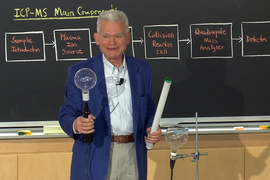
How free online courses from MIT can “transform the future of the world”

“A whole world of potential learners and potential knowledge to gain”

Festival of Learning 2023 underscores importance of well-designed learning environments

Innovation in the classroom
Previous item Next item
More MIT News

Weaving memory into textiles
Read full story →

3 Questions: Paul Cheek on tactics for new startups

Three from MIT named 2024-25 Goldwater Scholars

Physicists arrange atoms in extremely close proximity

Epigenomic analysis sheds light on risk factors for ALS
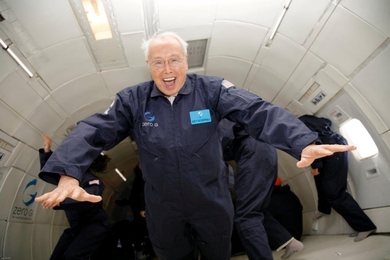
Francis Fan Lee, former professor and interdisciplinary speech processing inventor, dies
- More news on MIT News homepage →
Massachusetts Institute of Technology 77 Massachusetts Avenue, Cambridge, MA, USA
- Map (opens in new window)
- Events (opens in new window)
- People (opens in new window)
- Careers (opens in new window)
- Accessibility
- Social Media Hub
- MIT on Facebook
- MIT on YouTube
- MIT on Instagram

COMMENTS
Here are five ways to nurture your critical-thinking skills: Be a lifelong learner. Continuous learning through educational courses and professional development lets you stay current with evidence-based practice. That knowledge helps you make informed decisions in stressful moments. Practice reflection.
Successful nurses think beyond their assigned tasks to deliver excellent care for their patients. For example, a nurse might be tasked with changing a wound dressing, delivering medications, and monitoring vital signs during a shift. However, it requires critical thinking skills to understand how a difference in the wound may affect blood ...
The following are examples of attributes of excellent critical thinking skills in nursing. 1. The ability to interpret information: In nursing, the interpretation of patient data is an essential part of critical thinking. Nurses must determine the significance of vital signs, lab values, and data associated with physical assessment.
Learning to provide safe and quality health care requires technical expertise, the ability to think critically, experience, and clinical judgment. The high-performance expectation of nurses is dependent upon the nurses' continual learning, professional accountability, independent and interdependent decisionmaking, and creative problem-solving abilities.
In summary, critical thinking is an integral skill for nurses, allowing them to provide high-quality, patient-centered care by analyzing information, making informed decisions, and adapting their approaches as needed. It's a dynamic process that enhances clinical reasoning, problem-solving, and overall patient outcomes.
Lastly, we show that critical thinking constitutes a fundamental component in the research process, and can improve research competencies in nursing. We conclude that future research and actions must go further in the search for new evidence and open new horizons, to ensure a positive effect on clinical practice, patient health, student ...
Critical thinking is applied by nurses in the process of solving problems of patients and decision-making process with creativity to enhance the effect. It is an essential process for a safe, efficient and skillful nursing intervention. Critical thinking according to Scriven and Paul is the mental active process and subtle perception, analysis ...
Why Critical Thinking Skills in Nursing Matter (And What You Can Do to Develop Them) By Hannah Meinke on 07/05/2021. This piece of ad content was created by Rasmussen University to support its educational programs. Rasmussen University may not prepare students for all positions featured within this content.
Critical thinking is an integral part of nursing, especially in terms of professionalization and independent clinical decision-making. It is necessary to think critically to provide adequate, creative, and effective nursing care when making the right decisions for practices and care in the clinical setting and solving various ethical issues ...
Tips to improve your critical thinking skills in nursing. Here are several tips to enhance your critical thinking skills as a nurse: 1. Ask patients open-ended questions. It's important to give all patients the same standard of care. Asking patients to elaborate on their medical history or point of view may help you communicate more effectively ...
Significantly, this study is the first to use the text network method to analyze the subjective experiences of the critical reflective journals of new nurses. In conclusion, changes are needed to improve the education system for new nurses and promote efficient sharing of nursing tasks. KEY WORDS: Critical thinking, Diary, In-service training ...
Critical thinking in nursing is considered essential for delivering quality care and reflects the professional accountability of registered nurses (Chang et al., 2011 ). It is also a vital part of the clinical assignments and responsibilities nurses are expected to manage. Additionally, nurses' critical thinking has the potential to influence ...
The National League for Nursing Accreditation Commission ( NLNAC) defines critical thinking as: "the deliberate nonlinear process of collecting, interpreting, analyzing, drawing conclusions about, presenting, and evaluating information that is both factually and belief based.". Critical thinking in nursing does not move in a straight line ...
Nurses are critical thinkers. The characteristic that distinguishes a professional nurse is cognitive rather than psychomotor ability. Nursing practice demands that practitioners display sound judgement and decision-making skills as critical thinking and clinical decision making is an essential component of nursing practice.
Critical Thinking TACTICS for Nurses is a must-read for all clinicians, educators, and students. It tackles the seemingly nebulous topic of critical thinking and explains how our understanding of a clinical situation or disease process and its impact on the patient and family helps us cope and succeed in today's ever-changing health-care world.
There are many skills necessary to be an effective critical thinker. Decision-making and critical thinking need to happen together in order to produce reasoning, clarification, and potential solutions. To advance nursing practice, it is necessary to develop and evaluate strategies to help new nurses develop these essential critical thinking skills.
The Safe Care Framework ™ is an innovative pedagogy for critical thinking. •. Greater organization and understanding of complex acute care patients. •. Guiding of assessments and priorities. •. Better communication with others. •. Cognitive support for novice nurses to understand complexity.
1.2. Critical thinking in acute care nursing education. Active participation and problem-based learning are strategies used to promote critical thinking in the clinical environment ( Distler, 2007 ). Carter et al. (2016) reviewed teaching tools to promote critical thinking in nursing and midwifery students.
Additionally, critical thinking skills can help nurses who want to advance their careers. If you want to rise to a leadership position, you must demonstrate that you can think clearly about people's individual strengths, organize the nursing floor, and provide guidance to others. You must also be able to think about areas outside the nursing ...
Aim: Critical thinking is essential to quality health care and patient outcomes in the acute care setting. It is important for educators to understand and apply teaching and learning strategies to promote critical thinking of nursing students and junior nurses in acute care. Design: We followed Arksey and O'Malley's 2005 framework to undertake ...
Critical thinking is just one skill crucial to evidence based practice in healthcare and education, write Jonathan Sharples and colleagues , who see exciting opportunities for cross sector collaboration Imagine you are a primary care doctor. A patient comes into your office with acute, atypical chest pain. Immediately you consider the patient's sex and age, and you begin to think about what ...
They can apply critical thinking skills in decision‐making and problem‐solving, and they can develop strategies that help staff nurses to improve their critical thinking ability (Van Dyk et al., 2016; Wong, 2015; Zuriguel‐Pérez et al., 2018). Thus, the ability to think critically is necessary for nurses because it will help them to ...
The importance of critical thinking. Although generative AI can have positive impacts on educational experiences, users need to understand why large language models might produce incorrect or biased results. Faculty, instructors, and student panelists emphasized that it's critical to contextualize how generative AI works.
76 nursing programs participated in the study. The Reflective and Critical Thinking was found as a subject, subject content and didactic strategies. Of the 562 subjects reviewed, this type of thinking is found in 46% of the humanities area and 42% in the area of research and professional discipline. It is important to train teachers to achieve ...